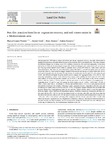Post-fire Practices Benefits on Vegetation Recovery and Soil Conservation in a Mediterranean Area

Use este enlace para citar
http://hdl.handle.net/2183/29893
A non ser que se indique outra cousa, a licenza do ítem descríbese como Atribución 4.0 Internacional
Coleccións
- Investigación (ETSECCP) [826]
Metadatos
Mostrar o rexistro completo do ítemTítulo
Post-fire Practices Benefits on Vegetation Recovery and Soil Conservation in a Mediterranean AreaData
2021Cita bibliográfica
Manuel López-Vicente, Artemi Cerdà, Henk Kramer, Saskia Keesstra, Post-fire practices benefits on vegetation recovery and soil conservation in a Mediterranean area, Land Use Policy, Volume 111, 2021, 105776, ISSN 0264-8377, https://doi.org/10.1016/j.landusepol.2021.105776. (https://www.sciencedirect.com/science/article/pii/S0264837721004993)
Resumo
[Abstract] Post-fire practices (PFP) aim to reduce soil erosion and favour vegetation recovery, but their effectiveness is spatially heterogeneous and under debate because of the economic and environmental costs. This study evaluates the different changes (Δ) of canopy cover (CC), sediment connectivity (SC) and local topography in four areas affected by the Pinet fire in eastern Spain (August 8th, 2018) and managed with: totally burnt with tree removal and long log erosion barriers (LEBs) (Pinet-1), partially burnt without PFP (Pinet-2), totally burnt with tree removal and short LEBs (Pinet-3), and totally burnt without PFP (Pinet-4). An unburnt nearby area was used as control site (Pinet-5). High-resolution images obtained before the fire and during two drone flights after the fire (10.5 and 5.5 months after the fire and PFP; and 18 and 13 months after the fire and PFP) were analysed; and LiDAR- and SfM-derived digital elevation models used to compute the Aggregated Index of SC (AICv2). After correcting calculations, because of the different input sources, and excluding the forest roads (=3.6% of the total surface), CC in the first post-fire scenario was of 25.5% (−40.4% with respect to the pre-fire scenario), 14.5% (−68.4%), 23.8% (−43.7%), 26.9% (−26.5%) and 29.6% (−32.7%) in Pinet-1, P-2_totally_burnt, P-2_partially_burnt, P-3 and P-4; and ΔCC among the drone flights were of +2.45%, +0.02% and +10.54% in Pinet-1, Pinet-3 and Pinet-4. The annual CC recovery rate decrease from 27.5% to 19.1% per year between the first and the second post-fire scenario, indicating a quick vegetation recovery, especially in the first year, and considering the surface area covered by rocks (=16.3%). Topographic changes indicated that not install LEBs favoured shorter flow length pathways after the fire, and thus, runoff will flow faster to cover the same area, achieving higher velocity and thus soil detachment capacity. Sediment connectivity increased in all burnt sub-sites after the fire (=+32.4%), but the increments in the two sub-sites with LEBs were 36% lower than the increase in the sub-sites without LEBs. The increase of connectivity in the first and second post-fire scenarios was −32% and −45% in the sub-site with long LEBs compared with the sub-site with short LEBs. Overall, LEBs effectively favoured vegetation recovery, lengthened overland flow pathways, and reduced sediment transport in the early months, but their usefulness was not as pronounced during the second post-fire year, although these results may be influenced by the Mediterranean conditions of the site.
Palabras chave
Forest fire
Log erosion barrier
Vegetation recovery
Sediment connectivity
Drone imagery
Log erosion barrier
Vegetation recovery
Sediment connectivity
Drone imagery
Descrición
Financiado para publicación en acceso aberto: Universidade da Coruña/CISUG.
Versión do editor
Dereitos
Atribución 4.0 Internacional






